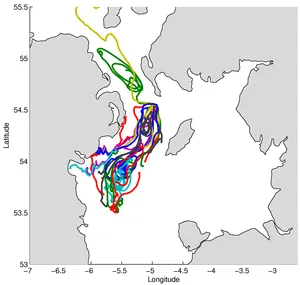
The vertical movement of scampi larvae in the Irish Sea is an important factor in determining the success of the species, according to scientists at the National Oceanography Centre (NOC) and the University of Liverpool.
The study, published in the journal Marine Ecology Progress Series, investigated processes that control the dispersal of scampi larvae, fundamental for the effective management of UK fisheries.
In the Irish Sea, between Ireland and the Isle of Man, a swirling marine ‘weather system’ – known as a gyre – develops in spring and remains trapped through late summer. This coincides with an important scampi spawning site. It was previously thought that the recirculating current helped confine the scampi larvae to this spawning region, aiding the continuation of the community.
But these theories, based on observations at fixed depths, assumed the larvae to be passive drifters, ignoring the tendency to move up and down in the water column.
“This study combines a high-end 3D ocean forecasting model with realistic larval behaviour to investigate the dispersal of the scampi larvae,” said Dr Jeff Polton, a researcher at the NOC and co-author on this study.
“It was found that the recirculating currents actually have no discernible impact on the retention of larvae over the natal patch, and so will not be at the mercy of any future changes to the character of the recirculating currents, as might have been expected.”

Lead author of the paper, PhD student Jack Phelps, said, “We found some evidence to support the idea that the gyre promotes local retention provided that the larvae remain fixed at the depth of peak gyral flow, however, this assumption is unrealistic, when we introduced larval behaviour we found that the gyre did not aid retention. This could have important consequences for effective marine management.”
The study also reinforces the expectation that the scampi community in the Irish Sea is not strongly connected to other scampi colonies, so their management needs to be effective. The authors urge caution over relying on limited marine observations when gathering evidence for designating Marine Protected Areas – to help protect the biodiversity of our seas, while enabling sustainable resource use.
“Studying these creatures in their natural environment is challenging and costly,” said Dr Polton. “Complex numerical tools help us develop hypotheses which can then be challenged with well targeted observational data.”
Phelps’ PhD studentship, tied to both the NOC and the University of Liverpool, was funded by the Natural Environment Research Council (NERC). “The collaboration between these institutions was vital to this research as it enabled us to pool resources and share ideas,” he said.
Co-authors Prof Alejandro Souza and Dr Leonie Robinson are based at the NOC and the University of Liverpool, respectively.